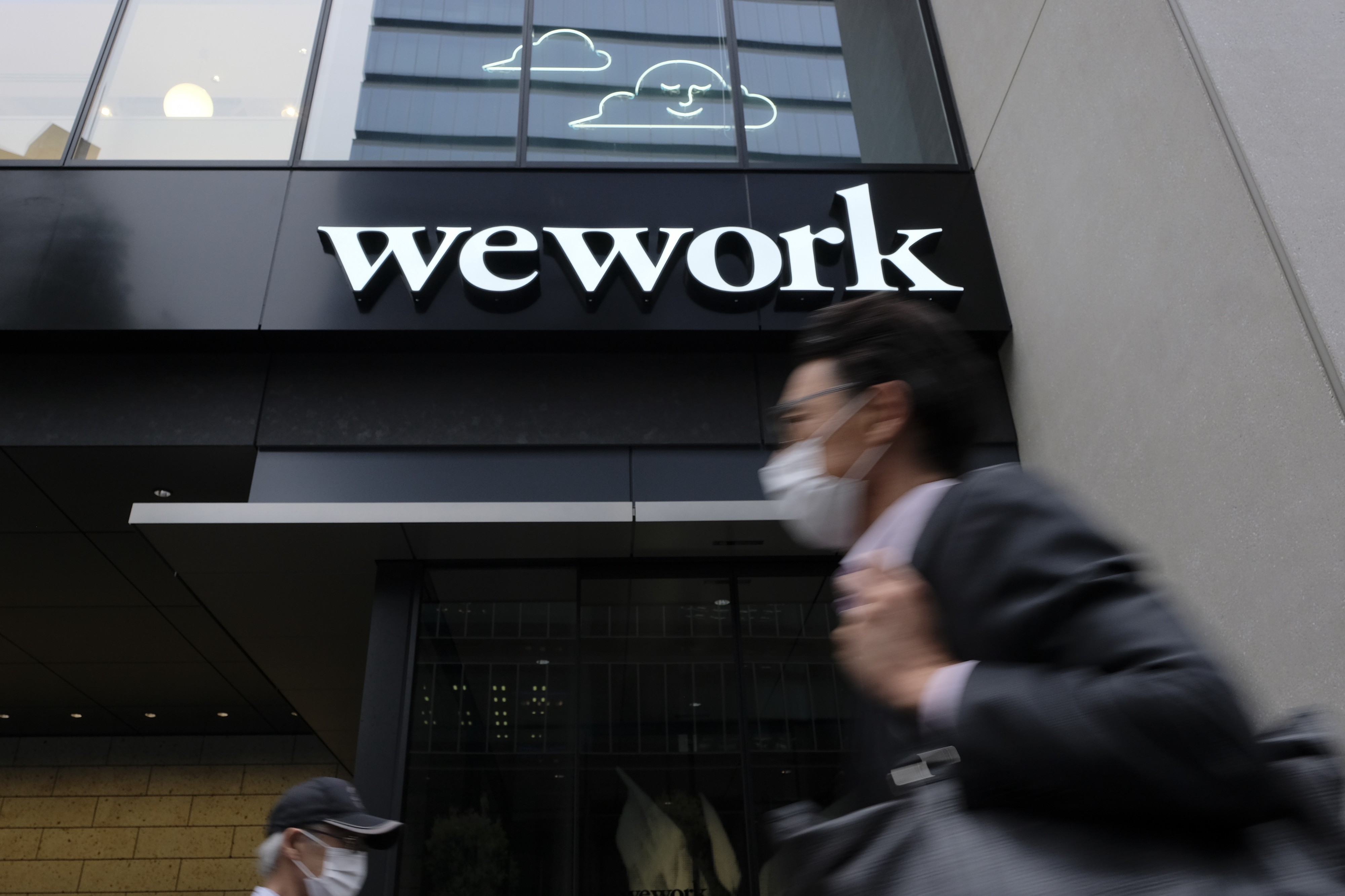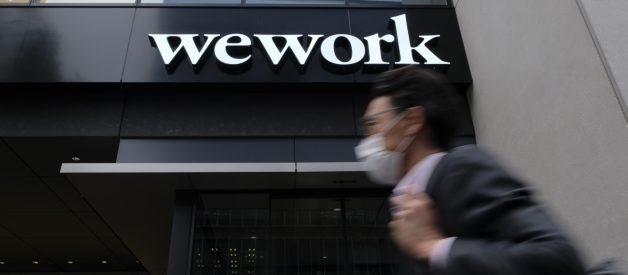The company plans to make over $7 billion in revenue by 2024. But first, it needs to survive.
 Photo: Kazuhiro Nogi/AFP/Getty Images
Photo: Kazuhiro Nogi/AFP/Getty Images
As of December, WeWork was weeks away from running out of cash, according to Marcelo Claure, the company?s executive chairman. This was less than a year after WeWork?s valuation rose to a high of $47 billion in January 2019, before plummeting to $8 billion in October after a disastrous attempt at an IPO. After the pandemic hit, the valuation dropped again to $2.9 billion in March 2020, as WeWork warned that the pandemic would likely get in the way of the company reaching its 2020 targets.
The whole industry has suffered because of the pandemic. A May 2020 report from Research and Markets projects the global co-working spaces market will ?decline from $9.27 billion in 2019 and to $8.24 billion in 2020 at a compound annual growth rate (CAGR) of ?12.9%.? Because of this, analysts at DBRS Morningstar were pessimistic about WeWork?s survival.
Before WeWork pulled its IPO, its mission was to ?elevate the world?s consciousness.? But with its valuation a shell of its former worth and office culture abandoned, the company suddenly had to pivot to clinging on for dear life.
On June 29, WeWork announced it would be ending its lease at its first location. It was a sign of a new hard-nosed approach to business ? an unwillingness to keep unprofitable offices around for sentimentality?s sake. And this July, just seven months after Claure told employees about WeWork?s precarious financials, he reiterated this newfound commitment to financial maturity over pie-in-the-sky growth goals by telling the Financial Times that the company was going to be profitable, and have positive cash flow, in 2021 ? one year ahead of schedule. Amazingly, despite its external problems ? such as Adam Nuemann?s lawsuit against SoftBank and the ongoing office exodus caused by the pandemic, which could continue to foil the company?s best-laid plans and threaten the entire commercial real estate industry ? WeWork seems to be working toward a clear turnaround strategy.
Here?s how WeWork has already begun to pivot away from its original world-domination ambitions toward simply surviving.
Cutting costs aggressively
In its infamous IPO prospectus, WeWork reported that its pursuit of rapid growth was keeping the company from seriously worrying about short-term profitability. This fast growth also, conveniently, served as cover for WeWork?s aggressive spending culture.
WeWork CEO Sandeep Mathrani has said recently that 85% of WeWork?s mature locations are profitable. For the rest, the company will rely on aggressive lease renegotiations to try to reduce its $47.2 billion worth of liabilities by 30%.
Since its IPO fell apart, WeWork has slowed its spending just as aggressively, from $1.4 billion in the final quarter of 2019 down to $482 million in the first quarter of 2020. In December, WeWork members reported noticing that expensive decorative books had been replaced by cheap ones, black branded mugs had been swapped with plain white ones, and free-flowing beer taps had been turned off. WeWork also laid off over half its team, going from 14,000 employees to 5,600. The layoffs extended to its contractors; in July 2020, WeWork cut nearly half of its cleaners in the U.K.. It also sold off many of its acquisitions, including Meetup and Flatiron School.
WeWork?s current focus bears greater resemblance to that of rival office real estate company IWG: profitability and steadier, less explosive growth. WeWork CEO Sandeep Mathrani has said recently that 85% of WeWork?s mature locations are profitable. For the rest, the company will rely on aggressive lease renegotiations to try to reduce its $47.2 billion worth of liabilities by 30%. And while WeWork used to double revenue year over year, its new finance chief, Kimberly Ross, told Bloomberg in May that revenue had increased 45% from a year earlier. That?s still nearly five times greater than IWG?s group revenue increase of 9.2% in 2019.
Claure told the Financial Times that the company ?had seen strong demand for its flexible workspaces since the start of the coronavirus pandemic.? Despite its cost cutting, WeWork will clearly need to prioritize investments in sufficient operational changes?such as policies geared toward office safety and social distancing?to weather the pandemic so it can pull off the second crucial step of its turnaround.
Selling flexible office space to larger companies
In October 2019, WeWork reported that 43% of its members were large companies with more than 500 employees, up from 30% in October 2017. In June, Mathrani said that 65% of WeWork?s new customers were large companies; he wants to get that number up to 70%. According to the Financial Times, Mastercard, TikTok owner ByteDance, Microsoft, and Citigroup, among other companies, signed new lease agreements with WeWork in July 2020.
Stability is obviously valuable in a pandemic, but there?s a limit to how much WeWork can hope for ? flexibility is, after all, a large part of what it offers.
The pandemic has provided an opportunity ? one where companies like Shopify, Facebook, and Twitter consider making remote work permanent. To accommodate this change, WeWork and IWG are both selling the vision of the ?hub and spoke? model of company workspaces. In this model, companies open fewer satellite offices and instead lease small spaces convenient to their remote workers. These companies can provide a WeWork membership to their new recruits as they potentially expand their hiring efforts around the world.
Large companies (as opposed to scrappy startups) are appealing to WeWork because there?s a possibility of them signing longer leases and expanding their spaces with WeWork over time. This prospective stability is obviously valuable in a pandemic, but there?s a limit to how much WeWork can hope for ? flexibility is, after all, a large part of what it offers. In July, Rakuten announced it would not be renewing its contract with WeWork. In September, IBM will be leaving its New York?based WeWork outpost, which used to be the office for 600 employees. WeWork?s survival will require filling these vast spaces, likely by working with new big-business customers.
Unloading its risk
While large companies can lease WeWork spaces or entire floors, they can also opt into a different type of deal where they pay WeWork a fee to build and manage their office space. For example, the pharmaceutical company Merck serves as the guarantor of the lease in its new office space deal with WeWork. This type of deal enables WeWork to preserve greater cash flow but also enables Merck to set up a more permanent headquarters for its spinoff Organon & Co. By acting as guarantor, Merck will minimize any disruptions WeWork?s business performance could have on Merck?s space.
While WeWork focuses on its core flexible workspace offering, it will also eventually start selling new products and services like insurance and tax consulting to members.
Large companies aren?t the only potential companies WeWork can partner with. Claure says he plans to partner with landlords for 10% to 50% of WeWork?s locations. The partnership may look similar to co-working rival Industrious working with the real estate company Hines. While WeWork focuses on its core flexible workspace offering, it will also eventually start selling new products and services like insurance and tax consulting to members.
In its March 2020 strategy and financial plan, published before the pandemic, WeWork made clear its plan to offer new enhanced memberships, office equipment, and access to a network for health benefits and payroll services in 2021, and to transform the company from co-working space into an ?end-to-end business solutions platform? by 2022.
With companies looking to make their workforce as flexible as their office space, it?s not difficult to imagine WeWork in the middle ? selling health benefits or insurance plans to contingent workers, leasing equipment to corporations, and eventually maybe even offering temporary staffing services. WeWork?s financial plan forecasts that by 2024, it will hit $7.7 billion in revenue.
For SoftBank, profitability is just the first step to a larger goal of getting WeWork to pay off. If WeWork is sold, or can go public, at a valuation of around $24 billion (according to Chris Lane, a senior analyst at Sanford C. Bernstein), SoftBank?s takeover will have been successful. But with even rival IWG?s earnings and valuation at a fraction of WeWork?s projections, this can sound like a long shot.
?No one is investing in a co-working company worth $20 billion. That doesn?t exist,? WeWork co-founder and ousted CEO Adam Neumann told Forbes in 2017. ?Our valuation and size today are much more based on our energy and spirituality than it is on a multiple of revenue.? Even though energy and spirituality did not make the company worth $47 billion, to Neumann?s first point, the WeWork brand can expand beyond office space. As CEO Sandeep Mathrani has said, ?WeWork is a verb.?
WeWork?s network and capabilities can make it a big player amid the commercial real estate disruptions in the pandemic, and the company may eventually be able to set itself in the middle of not only office space, but potentially all things related to business operations. While WeWork failed to spin its old ambitions into reality, it may have a chance to succeed with this new strategy, assuming the company manages to adapt fast enough to outpace the pandemic.


